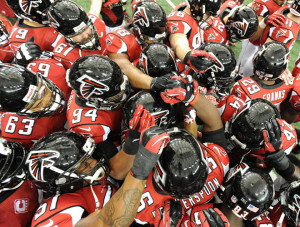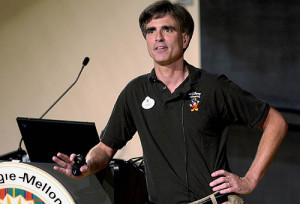Molly Fletcher's Blog, page 28
August 13, 2014
A Simple Word Exercise to Develop Leadership
“No matter what anybody tells you, words and ideas can change the world.”
 The schoolboys in “Dead Poets Society” learned that from their teacher—played by Robin Williams. His character inspired as a leader who was intent on developing leadership and critical thinking in his students. Reflecting on this amazing performance after Williams’ recent death, I’m struck by how leadership rests on the fundamentals of communication: the words we choose that represent the ideas that we believe in.
The schoolboys in “Dead Poets Society” learned that from their teacher—played by Robin Williams. His character inspired as a leader who was intent on developing leadership and critical thinking in his students. Reflecting on this amazing performance after Williams’ recent death, I’m struck by how leadership rests on the fundamentals of communication: the words we choose that represent the ideas that we believe in.
Working with coaches who may be new to their sports teams (such as a session I did at Georgia Tech recently) or managers who are newly supervising a corporate team, I often turn to a simple word exercise that helps these men and women establish a philosophy of leadership. It’s easy to replicate for any leader who wants to drill down to what is most distinctly their leadership style, and find the focus for his or her team to move forward together.
Leadership Values Card Sort
The coach or manager starts with a set of index cards. Each card has a value on it (empathy, integrity, passion, loyalty, etc.). Our sets have about 60 cards.
Keeping an open mind, each person uses the cards to answer the question, “What are the values supporting my leadership?” Each card belongs in one of these piles: A) values that are most important to your leadership; B) values that are not important to your leadership; and C) everything else.
Take the “A” pile (values that are most important). At most, this pile should have five cards. If you have more than that, narrow your choices by asking:
Is this value essential to who I am as a leader?
Does it compel me even in the face of adversity?
These cards represent your five (or fewer) core values that ground your leadership philosophy. Keep these handy.
On paper, make a list of the core values you selected. Beside each one, define it in your own words. What does it mean to you?
For each value, describe an example of how you have demonstrated, or will demonstrate, this value in your role as a leader.
Share these values with someone you trust, and keep honing these until they are sharply focused and can be shared with your team members.
It may sound almost too simple, but the reason this exercise is powerful is that the decisions necessary to complete this task are what leaders must do as a matter of course. Each coach or manager learns:
No leader can value everything, or the team would be overloaded, confused and unfocused.
Choosing core values involves critical thinking. Practicing this clarity through this exercise builds confidence for crisis leadership.
Determining core values is the first step to communicating core values. Find your brand then market it.
Keep your card deck! Another beauty of this exercise is that you can and will want to repeat it periodically. We are all dynamic humans, constantly in motion fueled by our inner motivations and external stimuli. As a result, our leadership style evolves over time.
Bonus Exercise: Developing Leadership Influences
One’s leadership style is never created in a vacuum. We are influenced by other people and groups and by our own experiences and personalities.
Write down one example of a person, place or situation that positively influenced you as a leader.
Write a similar example of a person, place or situation that negatively influenced you as a leader.
Analyze how both influenced your leadership philosophy. All of your experiences and relationships shape who you are as a leader today.
Takeaway
The two exercises are your research. Now craft a personal leadership statement. It can include how you lead, what you value, what you expect from team members, what you do not accept, and/or what type of environment you are committed to creating. The more concise your statement, the more likely you are to use it as a leadership compass. Remember, leadership is dynamic and this statement may very well evolve over time. Repeat these exercises to keep refining your leadership philosophy.
Molly Fletcher helps inspire game changers to lead well and with purpose. Her book, “A Winner’s Guide to Negotiating: How Conversation Gets Deals Done” (McGraw-Hill), will be published in September and draws on her decades as a sports agent and negotiator on behalf of pro athletes, coaches and broadcasters. Please click here to contact Molly.
August 7, 2014
Women Negotiating: What Makes Michele Roberts So Good
Recent headlines around Michele Roberts,  the first female leader of a major American sports union, naturally caught my eye.
the first female leader of a major American sports union, naturally caught my eye.
She’s perfect for the job, and she’s a perfect case study, especially for women in the negotiating world who strive to become even better at what they do. Roberts, who just became executive director of the National Basketball Players Association, laid a superb foundation for success that anyone (male or female) would do well to follow.
Here’s what stands out to me about Michele.
Set the stage early
Growing up in a housing project with two brothers and one TV, Roberts didn’t get to watch her shows. She was outnumbered. So she watched hoops instead. She studied the game.
Negotiating success begins by acquiring great knowledge. You have to know the fears and desires of the other side, the stakes, the possible outcomes. The more you know, and the deeper that knowledge goes into relevant details, the more you can establish authority and respect.
Find common ground
Roberts has a knack for finding common ground. Starting as a public defender, she became known as the ultimate litigator in the nation’s capital. To change someone’s mind or motivate him or her to move from their original position, you have to listen and connect with them.
At the heart of that process is putting ego aside (much like a soccer mom), embracing empathy, and authentically understanding what works best for both sides.
“It’s not hard if you start with respecting the jury,” Roberts was quoted in the Washingtonian magazine in 2011. “You become a juror. They’re reasonable and they’re smart and they’re honest. Don’t BS them. Don’t think you can avoid answering. You can’t ignore bad evidence. You can’t talk down to them. You can’t impress them with fancy language. You have to speak to them honestly and simply.”
Successful negotiating flows from open conversations
When Roberts went through the selection process with the players union, she obviously couldn’t hide her gender. She didn’t want it to work against her. The solution was to talk through it and move on to gender-neutral issues of competency.
“The only question in my mind, really, was, ‘Were they unwilling to give me a chance because I was a woman?’” she told Time magazine. “We had so many intelligent conversations about this issue. What’s most impressive to me is, once they saw my accomplishments and the value I can add, that didn’t stop them from making the offer, even while others may have predicted otherwise.”
Ask with confidence
Understanding the power of gender in negotiations, she has established her comfort level with who she is. That leads to asking with confidence.
“It’s important for women to break barriers,” she told Time. “But I don’t wake up and say, ‘Let’s break some barriers today.’ I wake up and say, ‘What do I have to do to best serve my client?’ And if I happen to break some barriers along the way, God bless me.”
Takeaways for women negotiating
Negotiators are competitors at heart, and Michele Roberts’ skill at negotiating—more than her knowledge of labor law or sports—made her the first women negotiating on behalf of a professional athletes union. Backed up by an outstanding record as a litigator, she aligned her story and abilities with that of the men she represents.
It’s common for an industry pioneer to first negotiate with her own expectations and perceived market value. With that clarity, Michele Roberts showed us how to break new ground for women negotiating.
To inspire game changers in business and beyond, Molly Fletcher draws on her decades as a sports agent and negotiator on behalf of pro athletes, coaches and broadcasters. Her book, “A Winner’s Guide to Negotiating: How Conversation Gets Deals Done” (McGraw-Hill), will be published in September. Click here to pre-order your copy.
July 28, 2014
Eliminate Sales Team Distractions Like NFL Coaches Do
Football season is around the  corner, and NFL players are reporting to training camps. It’s a compressed, intense time of preparation, and NFL coaches need everyone to be focused.
corner, and NFL players are reporting to training camps. It’s a compressed, intense time of preparation, and NFL coaches need everyone to be focused.
But how does a team do that when so much drama is playing out? Headlines are full of diversions like contract holdouts (running back Marshawn Lynch in Seattle), position battles (quarterback Johnny Manziel in Cleveland), rookies haggling over their first contracts and media hype related to team and player expectations.
To cut through that noise, NFL coaches use methods that sales teams, executive teams and other business groups can adapt to increase focus and eliminate sales team distractions.
Structure curbs diversions, fosters expectations.
Teammates move together through training camp with few breaks. They go to two-a-day practices, strength and conditioning workouts, team meetings. Like weeds, distractions need time and space to grow and take hold; the intensive schedule keeps this from happening.
Structure tells a team what is expected and what is not allowed. Be aware that creating structure without purpose or clarity can kill morale. Structure that is supportive and clear is much more effective for focusing team members. This kind of positive structure has the best interests of the team member in mind, and it builds trust and encourages balance. A well-built team often fosters a strong home base of support and this doesn’t happen without structure.
Separation limits distractions, communicates unity.
Teams stay together at their own special facilities or at an outside location (often a college campus). Players are removed from familiar places, people and things. It’s a positive disorientation that you might remember from summer camp. Family and friends aren’t around, and it’s time to see what you’re made of. The best way to do this is away from your busiest times, as a breather before the long haul.
How is separation different from segregation or elitism? Separation is a gift that allows team members a relative quiet away from the everyday static. Separation signals that they are gathered as special people for a special mission, and are expected to do their best (undistracted) work. This message is more powerful when it is shown rather than talked about, and by requiring team members to stay together away from their home, that’s what training camp accomplishes.
Variety energizes competition, spurs focus.
Unlike the regular season, training camp pits teammates against one another. The cutthroat “Survivor” setup has a purpose: They sharpen one another in preparation for the months of regular season competition. In training camp, the “me v. you” atmosphere is practice for the “us v. the world” when the season begins. It is the perfect time for this because everyone is undefeated and everything is possible.
Variety is any way that you change the dynamic to reveal the character of the teammate who has your back. You want to know this before you go into the fray, and being accountable helps counter distractions.
The takeaway
If your sales team faces distractions that keep it from its best work, the NFL offers ways to create a culture of clear expectations, loyalty and inspiration. Your grind may not be as glamorous as the NFL, but from rookies to veterans, everyone can benefit from greater focus that comes from improved structure, separation (physical or otherwise), and variety in competition.
With a deep background in professional sports representation, Molly Fletcher is all about inspiring game changers in sales and across business. Her book, “A Winner’s Guide to Negotiating: How Conversation Gets Deals Done” (McGraw-Hill), will be published in September. Click here to contact Molly.
July 22, 2014
Six Years Later: Why Motivational Speaker Randy Pausch Still Inspires
Recently I re-watched Randy Pausch’s Last Lecture. It’s been six years since he passed away, leaving an incredible legacy as a motivational speaker.
Pausch was a university  professor and father of three young kids who, while defying prostate cancer, summed up what he had learned in life in his final teaching lesson. That lecture was made into a book and continues to inspire.
professor and father of three young kids who, while defying prostate cancer, summed up what he had learned in life in his final teaching lesson. That lecture was made into a book and continues to inspire.
Why has it lasted? Here’s my analysis.
1. He welcomed feedback.
We all like compliments, and our nature is to defend ourselves against criticism. What is so counterintuitive and powerful is to turn that defensiveness into curiosity. Where others would close up, Pausch opened himself up for examination. That’s where growth is.
2. He considered imagination a gift.
We are born with the ability to see with our mind’s eye what is not in front of our physical eyes. It’s amazing how much we take this for granted—and leave it untapped. Imagination is an engine to make where we are better and to reveal where we will go next. As a motivational speaker, he left his audience with this spark.
3. He believed brick walls could help you.
We all face obstacles. Pausch pointed out that these exist as a measuring device. A brick wall reveals how badly we want to reach our goal. In the face of adversity, do you give up? That shows how much you truly desired your goal—or didn’t.
4. He grasped that humility matters.
Pausch recognized the power in understanding “it’s not about me.” From this space, you can do so much more than if you are self-centered.
5. He valued people more than things.
Most of us have work that focuses on objects. My latest thing is promoting my upcoming book. As much as I need people to buy it, I value my readers more. My foremost desire is that you succeed in negotiating, sales or whatever your goal. I hope my book can help you, but my overarching goal is to help equip you with inspiration and concrete methods for success. Pausch connected with strangers because they sensed his authentic care of them more than any object.
6. He sparked enjoyment.
Pausch had a great sense of humor. People loved his spirit. We all have our own definition of what makes us joyful. Go for it! Have fun! And never stop. A sense of play can point to our truest purpose.
7. He strived for integrity.
Every day we all face forks in our lives, where we can cut a corner or take the easy way out. No one will notice, right? What Pausch recognized was the opportunity to do the right thing was the chance to affirm your best self. The message he conveyed as a motivational speaker was that living with integrity is truly living.
8. He wasn’t afraid to apologize.
Too often we are all about defending our ground and making sure we are right. Too often winning means that someone has to lose. Competitiveness leads to reluctance to apologize. We don’t want to seem weak. Pausch reversed that and urged his students to own up to their mistakes. A timely, genuine apology is a sign of strength.
9. He didn’t complain.
Pausch became a famous example of terrible things happening to a good person. He could have gone underground … radio silence … his own well-deserved pity party. Instead, his strength was in owning his circumstances and moving forward anyway.
10. He played the game hard.
We’ve all got one shot at today, at this hour, at this minute. Then it’s history.
Takeaway
Randy Pausch recognized that he was living a precious, short amount of time, and his power as a motivational speaker came from his passion to share what he had learned about life. He filled his life and message with gusto—a word that in Latin means taste. He never lost his appetite for a full life, and pursued it to the fullest. Shouldn’t we all?
As a motivational speaker, Molly Fletcher draws inspiration and tools from a successful career as a sports agent. Her book, “A Winner’s Guide to Negotiating: How Conversation Gets Deals Done” (McGraw-Hill), will be published in September. Please contact us for more information on how she can help your team achieve its greatest potential.
July 16, 2014
Phil Mickelson Hired the Ultimate Team Building Consultant—and You Can Too
Phil Mickelson, like other  pro golfers, has one person at his side to help him compete in tournaments like the British Open this week: his caddie.
pro golfers, has one person at his side to help him compete in tournaments like the British Open this week: his caddie.
It’s a key decision. The caddie is a close consultant who, if the job is done right, makes Team Phil better equipped and more confident in this individual sport. A great caddie, and team building consultant, is a tactician, coach, cheerleader and psychologist all at once.
Phil’s caddie, Jim “Bones” Mackay, is what I like to call the Ultimate Team Building Consultant.
Here’s why. (This checklist can help you determine who will help build your most successful team).
1. He or she knows the pro(fession) from the ground up.
Mackay has carried Mickelson’s bag since 1992, one of the longest caddie relationships in pro golf. That’s 22 years of working side by side, half of Mickelson’s lifetime. He started playing golf as a kid, competed in college and then got into caddie work for Larry Mize, Scott Simpson and Curtis Strange. Those veteran pros trained Mackay well before he hooked up with Mickelson, who was a rookie at the time.
Likewise, a team building consultant should know your work from the inside out. He or she is prepared and equipped to help you meet the challenges of your industry. The ultimate team building consultant makes the most of your team’s strengths, and creates a synergy that fits your style.
Mackay’s familiarity and expertise with Mickelson draw admiration even from opponents.
“Phil and Bones are the best player/caddie partnership in golf,” Luke Donald tweeted after Mickelson won the British Open last year. “It’s hard to last as long as they have together yet they have done it with ease.”
2. The ultimate team building consultant knows that less is more.
The margins at the top of any industry can be miniscule. In pro golf, a single shot can make the difference between first place and everyone else. In one shot, momentum can shift, and a bad break or mistake can easily lead to another.
In this space, a caddie above all listens and observes; it’s a “speak when spoken to” occupation, where every word counts. A great caddie’s body language telegraphs calm and balance and confidence to his player no matter what the circumstance.
Likewise, a team building consultant can sort through a wide range of challenges on the fly while under pressure, and knows how to give feedback—and when to give it at all.
One of the most essential elements of Mackay’s role in last year’s British Open, according to the New York Times, was giving Mickelson a scoring target.
Going into the final round, Mickelson was five shots behind the leader, and Mackay estimated that an even par total would win.
“I’m going to be better than that,” Mickelson replied. A final-round 66 gave him his fifth major championship.
Mackay demonstrates how a great team building consultant doesn’t flood you with conversation and charts, but provides the right expertise at the right time.
A strong level of confidence leads to an expectation of top performance.
Mickelson “did seem to be really at peace today and very confident with what was going on,” Mackay told the BBC after last year’s Open win. “To go from where he was to the top of the leader board he had to be very calm.”
3. A great team building consultant never loses focus.
Mickelson is confident in himself because Mackay has him covered, literally. He is prepared with all the yardages and correct clubs. He knows the Rules of Golf inside and out, so Mickelson is protected from thoughtless penalties. Mackay keeps the equipment dry and clean no matter what the weather. A great caddie anticipates potential trouble spots while keeping up the player’s confidence.
Caddies are so good at these basics that when they fail, it’s news. A caddie is supposed to know where the ball is at all times, so the player doesn’t have to worry. At the U.S. Open, Hunter Mahan was battling to stay in the tournament, and his caddie led him to a ball in the fairway that turned out to be the wrong one. When Mahan hit it, he incurred a two-shot penalty, and ended up missing the cut by one shot. (When interviewed, Mahan’s caddie owned his mistake, which is part of regaining focus.)
The attention to detail leads to greater connection and appreciation in the client-consultant relationship. When Mickelson accepted the British Open Claret Jug last year, he thanked “my main man Bones.”
“Bones is the only guy on the golf course that wants me to play well, so why am I going to sit there and berate him and treat him poorly?” he was quoted in the New York Times. “He’s the only guy trying to work his tail off for me.”
The takeaway
As demonstrated by a great professional golf caddie like Jim Mackay, an ace team building consultant maximizing strengths in a way that is unobtrusive and thoughtful. He or she shares expertise that is well-timed and deeply authoritative. The client’s needs always come first, and that creates and expectation and tradition of success.
Molly Fletcher is an experienced team building consultant whose success at the highest level of pro sports has led her working with other highly competitive sales and executive teams. Click here for more information on how Molly can help you build a better team.



